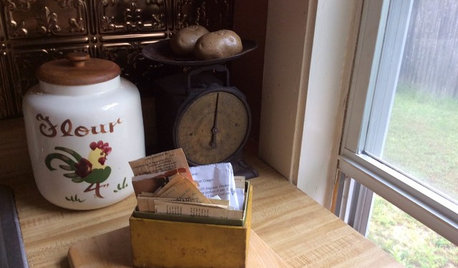Dog food recipe
nancyjane_gardener
9 years ago
Related Stories

KITCHEN DESIGNWorld of Design: Favorite Recipes From Food Lovers Around the Globe
Travel with your tastebuds and experience for yourself these international foodies' favorite dishes
Full Story
KITCHEN DESIGNKitchen Recipes: Factory Cart Inspires a Dream Cooking Space
These homeowners' kitchen was almost nonexistent, so they whipped it up from scratch. See what they cook there and get the recipe too
Full Story
KITCHEN DESIGNKitchen Recipes: Secret Ingredients of 5 One-of-a-Kind Cooking Spaces
Learn what went into these cooks’ kitchens — and what comes out of them
Full Story
LANDSCAPE DESIGNRecipe for Asian Edible Garden Style
A surprising number of food plants are hiding out in Asian-themed landscapes. Add a few more and extend the Zen flavor to the kitchen
Full Story
FARM YOUR YARD6 Things to Know Before You Start Growing Your Own Food
It takes time and practice, but growing edibles in the suburbs or city is possible with smart prep and patience
Full Story
KITCHEN STORAGEPantry Placement: How to Find the Sweet Spot for Food Storage
Maybe it's a walk-in. Maybe it's cabinets flanking the fridge. We help you figure out the best kitchen pantry type and location for you
Full Story
KITCHEN DESIGN5 Home Cooks Share Their Favorite Family Recipes
Peek inside the kitchens of these Houzz users and learn how to cook their time-tested, passed-down dishes
Full Story
KITCHEN DESIGNChristmas Recipes From ‘Love the Coopers’
Get the recipes for dishes seen in the new movie opening November 13
Full Story0

LANDSCAPE DESIGNRecipe for Modernist Edible Garden Style
Herbs, vegetables and fruit trees aren’t just for traditional gardens. Here’s how to design them into modernist landscapes
Full Story
KITCHEN DESIGNSweet Ideas and a Truffle Recipe from a Chocolatier's Test Kitchen
A $2,100 budget didn't mean a half-baked kitchen redo; this confectioner just rolled up her sleeves and rolled out the improvements
Full StoryMore Discussions






Anne Wolfley
malna
Related Professionals
Vernon Hills Landscape Architects & Landscape Designers · Paradise Landscape Architects & Landscape Designers · Wakefield Landscape Contractors · Edmond Landscape Contractors · Wilmington Landscape Contractors · Cedar Hill Landscape Contractors · Hannibal Landscape Contractors · Huntington Landscape Contractors · Hurricane Landscape Contractors · Reedley Landscape Contractors · Uxbridge Landscape Contractors · Northlake Landscape Contractors · Austin Roofing & Gutters · Staten Island Roofing & Gutters · Valley Stream Roofing & GuttersAnne Wolfley
malna
Anne Wolfley
nancyjane_gardenerOriginal Author
Ninkasi
Acadiafun
malna